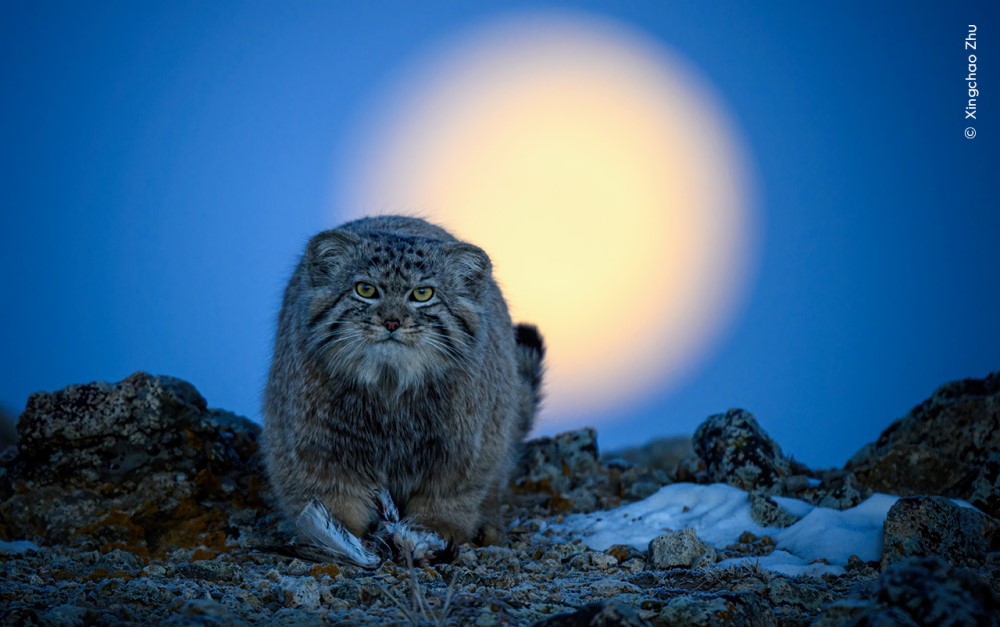Wildlife Photographer Of The Year is back for its 60th anniversary and ahead of the big competition announcement, they’ve released some of the highly commended images for 2024. Among the photos we’re treated to the world’s grumpiest cat, the many talents of jackdaws, a picture-perfect forest scene, an army of mussels, and a baby manatee looking cuter than any wild animal rightly should. However, it was the David Bowie spider that really stole our attention.
Ziggy Spider is a highly commended image in the Behaviour: Invertebrates category, awarded to photographer Lam Soon Tak. A fittingly gothic shot for Bowie’s swansong, Blackstar, but its species name is a tribute to another celestial album title.
Heteropoda davidbowie was described by Dr Peter Jäger in 2008 with a name “honouring the rock-singer David Bowie – composer of the music album ‘The Rise And Fall Of Ziggy Stardust And The Spiders From Mars’ album and interpreter of songs such as ‘Glass Spider’ who has been in early years of his career sometimes as painted as the frontal view of the head of this new species…”
Lam was exploring the Cameron Highlands in Pahang, Malaysia, when he came across this spider carrying an egg sac. We see it perched on two branches on a river, with the bright white disc of eggs in the spider’s jaws resembling a mini planet.
Moonlight Hunter
Image credit: Xingchao Zhu / Wildlife Photographer of the Year
This shot is titled Moonlight Hunter and was taken by Xingchao Zhu from China. It was awarded highly commended in the category Behaviour: Mammals, and shows arguably the world’s grumpiest cat face-on to the camera: a Pallas’s cat.
While tracking a group of Pallas’s cats on the freezing plateau of Hulun Buir, Inner Mongolia, China, Xingchao made eye contact with one of the cats just as it had caught a small bird. These cats are well suited to the cold with thick coats that protect them against the frosty conditions experienced at extreme altitude. In fact, scat sampling even placed Pallas’s cats on Everest for the first time back in 2023.
Precious Rocks
Image credit: Samual Stone / Wildlife Photographer of the Year
A jackdaw was spotted exhibiting better transportation of objects skills than most humans demonstrate while unloading their car. Taken by Samual Stone, this shot Precious Rocks earned highly commended for the category Behaviour: Birds.
Samual was spying on a hole in the trunk of a half-fallen willow tree in London’s Bushy Park where he’d seen a pair of jackdaws. They were mostly returning with beaks full of deer hair, one of several things they need to build a decent nest. Then, one bird returned with quite the mouthful: a series of stones seemingly arranged in perfect size order. Is there anything the corvids can’t do?
In The Spotlight
Image credit: Shreyovi Mehta / Wildlife Photographer of the Year
I don’t know about you, but I would really love to be in this photo right now. In The Spotlight was taken by Shreyovi Mehta, a promising new talent who was awarded runner-up in the 10 Years And Under category.
The picture-perfect scene shows two Indian peafowl silhouetted in the opening of a forest where Shreyovi was walking with her parents. She ran back to her dad, who was carrying the cameras, then got down on the ground to take this photo from a low angle.
This beautiful forest is in the Keoladeo National Park in Rajasthan, India, and it’s renowned for its birdlife, attracting large numbers of water birds in winter. The peafowl are, however, a year-round resident that roosts in large trees and rests during the day, becoming more active at dawn and dusk.
Strength In Numbers
Image credit: Theo Bosboom / Wildlife Photographer of the Year
Here we see Praia da Ursa in Sintra, Portugal, looking like a scene fresh out of Game Of Thrones. This shot, Strength in Numbers, was taken by Theo Bosboom and it shows an army of mussels banding together to survive the harsh coastal waters. The picture was awarded highly commended in the Animals In Their Environment category.
Mussels aren’t a regular star at wildlife photography exhibitions, which is precisely why Theo wanted to photograph them. His specialty is capturing images of species that aren’t usually considered beautiful or important, to highlight their unappreciated significance.
As one of the ocean’s great filter feeders, mussels have a crucial influence on the environment by extracting plankton, as well as bacteria and toxins, from the water, preventing them from building up to dangerous levels. They’re a vital ingredient for a dynamic ecosystem, and I think look pretty damn spectacular in their own, brutal way.
As Clear As Crystal
Image credit: Jason Gulley / Wildlife Photographer of the Year
And finally, for a bit of the ahhh factor, we have As Clear As Crystal by Jason Gulley. This incredible photograph was awarded highly commended in the Underwater category, and shows a manatee and a calf drifting among the eelgrass in Hunter Springs, Crystal River, Florida, USA.
Jason is no stranger to manatee photography, but this picture earned a special place in his heart thanks to the expression on this calf’s face and the bubbles trailing from its flippers. A joyous photo that comes with a joyous conservation story to boot, as this eelgrass the manatees depend on was once threatened by an algal bloom that was triggered by agricultural runoff. Local action has restored the habitat, and the manatees are back to enjoying their eelgrass in crystal-clear waters. In fact, the winter of 2022/2023 saw the largest number of manatees in the region on record.
A lot to clap your flippers at already from this year’s submissions and we haven’t even got to the winners yet. Keep your eyes peeled for more announcements about Wildlife Photographer Of The Year, developed and produced by the Natural History Museum, London.
Source Link: David Bowie Spider Steals The Show Ahead Of 60th Wildlife Photographer Of The Year
